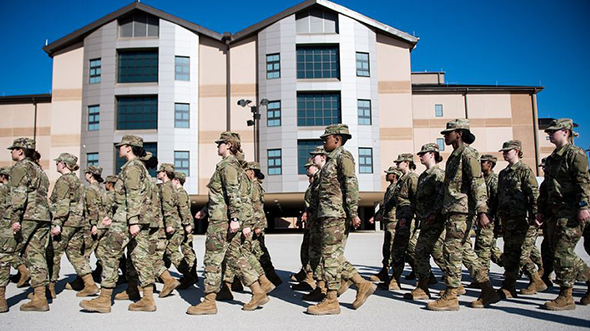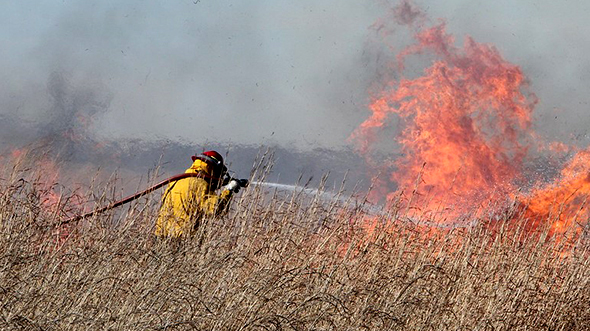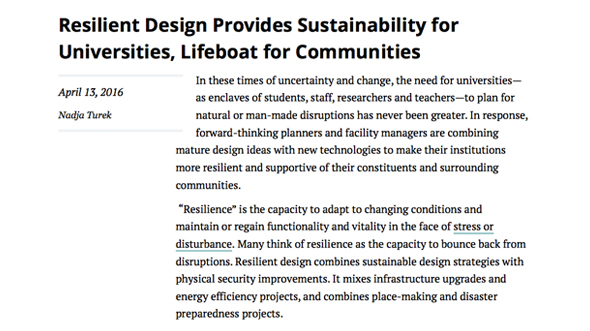
Photo by David Dekunder
BLOG
—
Installation Energy and Water Plans (IEWPs) Target Energy, Water Resilience in Military Planning
In 2016, the Assistant Secretary of Defense for Energy, Installations and Environment ASD (EI&E) directed all U.S. Department of Defense (DoD) installations to prepare an installation energy plan (IEP). The purpose of this plan is to coordinate higher-level energy initiatives, planned energy projects and the installation’s master plans. “All IEPs will incorporate long-range plans for energy resilience capabilities to ensure available, reliable and quality power for each of the installation’s critical missions,” according to the ASD (EI&E). In a nod to the equally and arguably more important role of water, some branches of the U.S. Armed Forces have developed Installation Energy and Water Plans (IEWPs), which take into account both energy and water resilience.
Energy and water assurance is key to ensuring military installations can perform mission-essential functions under adverse conditions. IEWPs aim to help installation decision-makers look across missions and various component plans before investing in energy and water assurance upgrades. This type of plan’s holistic review helps ensure requirements are not identified in isolation, capabilities are not developed in silos and resources are used efficiently.
In the last 18 months, Woolpert’s military master planning team, supported by our engineers, has been working on IEWPs for an Air Force and Army installation. Here are a few key takeaways from our experience.
A Shift in Thinking
Management of an IEWP is typically delegated to the installation energy manager, who has been inculcated in a culture where pay-back and savings-to-investment ratio are the rule for project funding. IEPs typically were energy efficiency plans, but now we’re asking installation leaders to pivot to a mentality of risk reduction, energy security, water security and mission assurance. Instead of asking, “Which project will pay for itself over time?” or “Which will reduce our total cost of ownership?” IEWPs ask, “Which project will make the installation more resilient during a disruption or incident?”
It’s not a foreign way of thinking for people who have spent their careers around the military. But for energy managers, it is natural to primarily focus on efficiency projects because of past federal mandates to reduce energy and water use intensity and past prioritization of funding based on pay-back. Although efficiency is a huge resiliency enabler and still a key factor in IEWPs, it is relegated to a key supporting role.
We Must Care About Water, Really
Water has been the less-loved stepchild in military installations’ energy and sustainability programs. Water rates in the U.S. are generally low and often make water-savings projects financially unattractive. By contrast, energy rates in some markets are high enough and technology solutions have become affordable enough to justify project costs over time. LED retrofits are good examples of that dynamic. Also, energy rates can be complex in some markets, driving projects that shift loads to the night or store energy.
With exceptions, generally those project drivers do not apply to the world of water. As a result, water-savings goals have played second fiddle and fewer water projects have been funded. When discussing resiliency however, water can often become a higher priority than energy, and some energy assurance projects are driven by the need to maintain continuous operation of the water system. For example, when an installation considers a prolonged power outage to a densely occupied training barracks, they know their trainees can last a long time without power but not without sanitation. Be ready for water’s come-uppance!


You Only Think You Have a Critical Facilities List
We have worked with several installations and talked with peers who are preparing IEWPs for many installations. A common stumbling block has been furnishing a critical facilities list relevant to the IEWP. A critical facilities list exists at every installation. This is the military, and mission-readiness is imperative. Through exercises and real-world incidents, our military is laser-focused on accomplishing its missions. So, where’s the catch? Once an installation’s list of critical facilities (and there may be more than one) is viewed through the lens of longer-duration power and water disruptions, which are typically not considered during emergency planning, those priorities shift and the list of critical facilities can become inadequate. As we work through installation-specific resiliency planning scenarios with stakeholders, the critical list morphs. This is a healthy part of preparing the IEWP.
What’s the Requirement?
A conundrum that faces the IEWP stakeholder team is, “How resilient is resilient enough?” The IEWP process involves an installation setting its own energy and water vision and goals for the first time. In the past, energy and water efficiency goals were dictated by laws, executive orders (EO) and DoD-level policy. Metrics like energy use intensity (EUI) and water use intensity (WUI) are tracked across the federal government for consistency. Sweeping EUI or WUI reduction goals were mandated whether an installation’s mission was growing, shrinking or changing. As most EOs have been revoked and many reduction deadlines have passed, we are now facilitating installation stakeholders through a very valuable, healthy process to establish their own goals with a focus on resiliency and efficiency.
Dealing with Privatized Systems
There has been a concerted push to privatize installations’ utility systems, where practicable, when local utility providers can more reliably deliver power and water. At those bases, privatization often lead to lost staffing and expertise with those systems. The IEWP process raises questions such as “How redundant is the power and water supply?” “How quickly can you respond to an outage?” and “Are there spare parts on hand?” These questions are directed to the privatized utility, and it becomes clear how dependent installations are on their utility partners for mission assurance. Utility provider contracts written a decade ago may not meet current resiliency goals. Therefore, the IEWP will contain recommended projects and management practices that affect the privatized utility.
To installation managers, it’s a mixed message to have privatized systems and then to plan actions or projects for systems that are now outside their control. Energy and water managers need to take a page from the playbook of military planners, who have been exerting influence and leveraging community partnerships for decades to reach desired outcomes outside-the-fence (e.g. for land use ordinances, noise abatement programs). Many IEWP projects will not come about via programmed projects, but rather via grants, partnerships and relationships with utilities, local governments, advocacy groups and service contractors.
A Mix of Management Actions and Projects
Building on partnerships and relationships, the IEWP may initiate more programmatic recommendations than internally funded, brick-and-mortar projects. Some big-picture opportunities will take shape—building a microgrid in a cluster of critical buildings, creating a substation interconnection that makes power more resilient or adding wells for on-base water production. Additional best management practices will also be identified and documented—for example, to build partnerships or work on data-sharing protocols to improve readiness exercises.
Final Thoughts
We have found that preparing an IEWP has been an interesting and challenging process for the stakeholders involved. It’s exciting to implement the policy pivot to energy and water assurance and resilience by creating a unique plan for each installation. These plans provide a variety of benefits:
- A shift in thinking toward resilience and mission assurance
- Installation-specific energy and water visions and goals
- Risk assessments based on current and future climate conditions
- Freshly vetted critical facilities lists
- Capabilities assessments and gap analyses
- Lists of new projects and best management practices for installations to pursue and implement
As we look ahead at the new requirement for Installation Resilience Component Plans (RCP) that Congress prescribed in the National Defense Authorization Act of 2020, we see that IEWPs accomplish some but not all the objectives of an RCP. If an installation already has an IEWP prepared, preparing an RCP would be faster and easier. Similarly, if an installation prepared an RCP, we believe it could and should cover all the energy and water requirements in the process, preventing the need to prepare a separate IEWP.

Nadja Turek
Nadja Turek, PE, F. SAME, LEED AP BD+C, ENV SP, WELL AP, GGP, a civil engineer serves as Woolpert’s sustainable design expert. As a former faculty member at the University of Dayton and the Air Force Institute of Technology, Turek is a sought-after teacher and speaker. She has provided sustainability training to over 1,000 designers and engineers and currently serves as an advocacy chairperson for USGBC’s Cincinnati Chapter.

David Helter
Woolpert Military Planner and Project Manager David Helter, AICP, conducts physical and environmental planning studies, prepares master plans and provides environmental impact studies for U.S. military installations in the U.S. and Europe. Helter served in the U.S. Army and works out of Woolpert’s Dayton, Ohio, headquarters.


